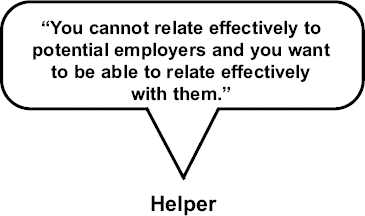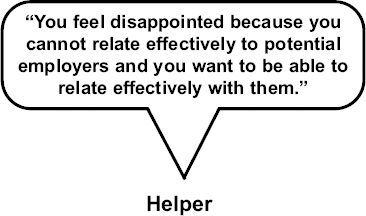Personalizing goals is the simplest transitional step. If we have personalized the problem effectively, then we should be able to personalize the goal fluidly.
Personalizing goals involves establishing where the helpees want to be in relation to where they are. It involves communicating the helpees' disappointment for some acknowledged responsibility in failing and communicating the helpees' relief and excitement in a direction or solution. The basic way to personalize goals is to determine the behaviors that are the opposite of the personalized problem. Thus, the goal can be described as the “flip side” of the problem. Personalizing goals involves conceptualizing, internalizing and specifying desired or needed assets.

PERSONALIZING GOALS
Just as we conceptualized the deficits, so do we now conceptualize the desired assets. We simply reverse the question “What is there about the helpees that is contributing to the problem?” by asking, “What might contribute to resolving the problem?” Usually, we can find the desired assets by directly reversing the deficits. Thus, for example, an interpersonal skills problem, or deficit, implies an interpersonal skills goal, or asset. In other words, the goal behavior can be defined as the opposite or “flip side” of the problem behavior. We may conceptualize the needed asset by thinking in terms of the format: “You cannot (problem/deficit) and you want to (goal/asset).”

CONCEPTUALIZING ASSETS
To assist the helpees in internalizing the assets that they need, we will formulate responses that communicate what it is that the helpees will do to solve their problems. Our “additive” personalized responses will assist the helpees to understand their roles in their solutions or goals. Our responses will answer the helpee’s internalizing question: “What is it that I will do to contribute to solving the problem?”
When formulating a personalized response that internalizes the desired assets, we may think in terms of the format: “You feel ________ because you cannot (problem/deficit) and you want to (goal/asset).”

INTERNALIZING ASSETS
We will want to specify potential desired assets just as we specified deficits. Again, we may need to search out some sources of expertise in specifying these assets. We are beginning to determine which specific assets will be needed to achieve the helpees’ goals. Assets are described as a behavior or series of behaviors. When we specify the assets, we are making the goals achievable. In specifying assets, we may use the formula: “You feel ________ because you cannot (problem/deficit) and you want to (goal/asset).”

SPECIFYING ASSETS
Just as we personalized changing feelings about deficits or problems, so do we personalize changing feelings about assets or goals. Similarly, just as “down” feelings are usually attached to problems, so are “up” feelings, or feelings of happiness, usually attached to goals. Thus, the helpees usually become hopeful for their futures or pleased with having a direction. We continue to ask the empathy question: “How would I feel if I were the helpee?” In personalizing feelings about goals, we may use the format: “You feel ________ because you are going to ________.”

PERSONALIZING CHANGING FEELINGS ABOUT ASSETS
The helpees inform us of their readiness to move from understanding to action. They alert us by demonstrating their ability to formulate and communicate their understanding of their goals. In other words, the helpees inform us of their readiness by doing for themselves the things that we have been doing for them.

HELPEES SIGNAL THEIR READINESS TO MOVE FROM UNDERSTANDING TO ACTION
